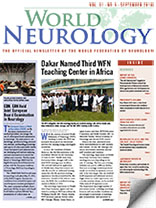By Carrie Grouse, MD

Carrie Grouse, MD
In reading Landmark Papers in Neurology, the famous quote by Sir Isaac Newton, “If I have seen further, it is by standing on the shoulders of giants” comes to mind as an appropriate aphorism. The sheer scale of progress made in our understanding of neurologic pathophysiology and treatment over the last few centuries, through advancements in the fields of anatomy, molecular biology, genetics, and neuroimaging, is made evident throughout this collection. Moreover, in this book, we are shown the indefatigable efforts of the scientists and clinicians, who, by a combination of tireless effort, excellent scientific method, and at times pure serendipity, managed to make these discoveries.
Divided into 16 sections encompassing many major areas of neuroscience, the contributor or contributors for each section selected 10 important papers in each field that were particularly crucial in transforming and advancing understanding and making possible further breakthroughs. The articles themselves are not included in the volume; rather they are succinctly summarized, with the bulk of attention being paid to the scientific, social, and, at times, political context in which these papers arose, as well as the impact the papers had on their respective fields.
 Although it is generally understood that all medical specialties constantly are growing and evolving with new scientific and technological advancements, this collection shows just how dramatically neurologic paradigms have been transformed completely through these landmark discoveries. Given the wide breadth of immunomodulatory therapies for multiple sclerosis, it is surprising to think that the first articles investigating the possibility of the use of interferon therapy in multiple sclerosis was only in the early 1980s, and treatment with interferons was only approved in the early 1990s. It seems equally surprising that in such a prevalent disease as epilepsy, so little was known about its cause until the first article describing electroencephalography in 1929, particularly given the dramatic advancements in the field of epilepsy since then.
Although it is generally understood that all medical specialties constantly are growing and evolving with new scientific and technological advancements, this collection shows just how dramatically neurologic paradigms have been transformed completely through these landmark discoveries. Given the wide breadth of immunomodulatory therapies for multiple sclerosis, it is surprising to think that the first articles investigating the possibility of the use of interferon therapy in multiple sclerosis was only in the early 1980s, and treatment with interferons was only approved in the early 1990s. It seems equally surprising that in such a prevalent disease as epilepsy, so little was known about its cause until the first article describing electroencephalography in 1929, particularly given the dramatic advancements in the field of epilepsy since then.
It was fascinating to follow the progression of knowledge in the area of Parkinson’s disease, from a humble treatise written by a relatively obscure apothecary about the “shaking palsy,” to the discovery of L-dopa as a revolutionary treatment, and more recently to the development of deep brain stimulation. Equally captivating was the recounting by Peter Goadsby, MBBS, of the circuitous path that was taken toward understanding the mechanisms behind migraine, and the substantial setback to the field that was caused by the “vascular dogma” proposed in 1938, which took 50 years to fully reverse.
Some of the most compelling aspects of this collection are the details included about the social, political, and even personal backdrops in which these discoveries were made. The seminal work performed by Alan Hodgkin and Andrew Huxley in elucidating the molecular basis of neurotransmission through their experiments on giant squid axons was almost abandoned, first due to being forced to work on radar development in World War II, then due to lack of ability to successfully catch squid for their experiments. The first description of an epileptic syndrome, West Syndrome, was in a letter to the editor of The Lancet by Dr. William James West, regarding a syndrome of unusual flexor spasms along with developmental regression that he noted in his own son. I was surprised to learn that Dr. Mary Walker, a female house physician at St. Alfege’s Hospital in London, was the first physician to treat a myasthenic patient with a cholinesterase inhibitor (physostigmine) after hearing that myasthenia gravis resembled curare poisoning, which had been found to be reversed with this agent. The political maneuvering and sabotage between competing scientists, hospitals, and laboratories, and the dramatic effect this had on what was published and how quickly new ideas were embraced, was also touched on throughout this collection, and made for fascinating reading. I often found myself regretting that each article was only afforded a few pages, such that these anecdotes were cut short.
Although a relatively minor issue, it seemed that the format of 10 articles per section was a little too strictly adhered to; some topics, such as neuroimmunology or mitochondrial diseases, could have been well covered if limited to only a few of the more seminal articles, whereas in the fields of stroke and dementia it seemed that 10 articles was impossibly limiting. Overall, however, the contributors and editors did a marvelous job with the daunting task of distilling a rich body of literature spanning multiple centuries. This book is well worth the read, as an excellent and inspiring review of the huge strides that have been made in the field of neurology in the last few centuries. It is intriguing to think of how much farther we will see in the future, thanks to the continued hard work, ingenuity, and serendipity of clinicians and scientists yet to come.
